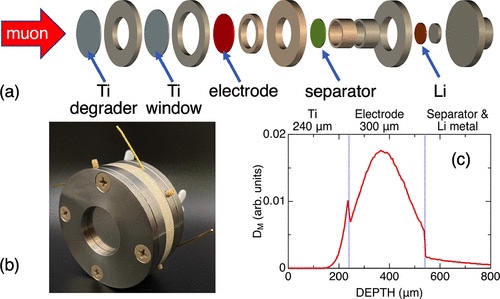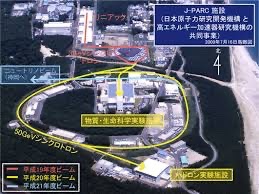

J-PARC: Movement measurement of Li ions!
ーJ-PARC MLF Muon Science Research Facility Open to the Publicー
Comprehensive Research Organization
Neutron Science Center
“In a lithium-ion battery during charging and discharging”
Succeeded for the first time in measuring the movement of lithium ions.
lithium ion:
Lithium ions in the positive electrode,
Calculate the “self-diffusion coefficient that indicates the speed of movement due to thermal motion”,
He showed that “this depends on the lithium ion concentration.”
This will lead to the search for materials for next-generation batteries and the optimization of electrode fabrication methods.
It is a joint research of “Tokyo University of Science, High Energy Accelerator Research Organization”.
lithium ion
exercise measurement
The “ion diffusion coefficient” is an important factor that determines battery performance.
Conventional measurement method:
In the conventional method,
It is affected by the electrode fabrication method and charge/discharge conditions.
“Obtaining material-specific diffusion coefficients” was difficult.
high intensity proton accelerator
“J-PARC”
At the Japan Proton Accelerator Research Complex “J-PARC”,
A technique called the muon spin rotation relaxation method (μSR) was used.
“Lithium ions in positive electrode material lithium cobalt oxide during charging and discharging” were investigated.
Lithium cobaltate
lithium ion
as a result,
The self-diffusion coefficient of lithium ions is
It turned out to be “10 to the minus 12th power – 11th power cm per second”.
This diffusion coefficient was shown to “increase with decreasing lithium ion concentration.”
Micro nuclear magnetic field of matter
Fluctuations and magnetic states
“Muon spin rotation relaxation method (μSR)”
When the muon injected into the sample decays,
Detects positrons and electrons emitted in the spin direction.
The muon spin is
Finding the orientation change caused by sensing the magnetic field,
Fluctuations and magnetic states of minute nuclear magnetic fields inside materials have been investigated.
(New Switch)-Yahoo! News
https://news.yahoo.co.jp/articles/8bcae4e50411506a7cd23e7fac574a0f002eba34
J-PARC : Mesure du mouvement des ions Li !
ーJ-PARC MLF Muon Science Research Facility ouvert au publicー
Organisation de recherche globale
Centre des sciences neutroniques
“Dans une batterie lithium-ion pendant la charge et la décharge”
A réussi pour la première fois à mesurer le mouvement des ions lithium.
lithium-ion :
Ions lithium dans l’électrode positive,
Calculer le “coefficient d’autodiffusion qui indique la vitesse de déplacement due au mouvement thermique”,
Il a montré que “cela dépend de la concentration en ions lithium”.
Cela conduira à la recherche de matériaux pour les batteries de nouvelle génération et à l’optimisation des méthodes de fabrication des électrodes.
Il s’agit d’une recherche conjointe de “Tokyo University of Science, High Energy Accelerator Research Organization”.
lithium-ion
mesure de l’exercice
Le “coefficient de diffusion des ions” est un facteur important qui détermine les performances de la batterie.
Méthode de mesure conventionnelle :
Dans la méthode conventionnelle,
Elle est affectée par la méthode de fabrication des électrodes et les conditions de charge/décharge.
“L’obtention de coefficients de diffusion spécifiques au matériau” était difficile.
accélérateur de protons à haute intensité
“J-PARC”
Au Japan Proton Accelerator Research Complex “J-PARC”,
Une technique appelée méthode de relaxation par rotation du spin du muon (μSR) a été utilisée.
“Les ions lithium dans le matériau d’électrode positive, l’oxyde de lithium-cobalt pendant la charge et la décharge” ont été étudiés.
Cobaltate de lithium
lithium-ion
par conséquent,
Le coefficient d’autodiffusion des ions lithium est
Il s’est avéré être “10 puissance moins 12 – puissance 11 cm par seconde”.
Il a été démontré que ce coefficient de diffusion “augmente avec la diminution de la concentration en ions lithium”.
Champ magnétique micronucléaire de la matière
Fluctuations et états magnétiques
“Méthode de relaxation par rotation des muons (μSR)”
Lorsque le muon injecté dans l’échantillon se désintègre,
Détecte les positrons et les électrons émis dans la direction du spin.
Le spin du muon est
Trouver le changement d’orientation causé par la détection du champ magnétique,
Les fluctuations et les états magnétiques de minuscules champs magnétiques nucléaires à l’intérieur des matériaux ont été étudiés.
(Nouveau commutateur) – Yahoo Actualités
J-PARC: Bewegungsmessung von Li-Ionen!
ーJ-PARC MLF Myon Science Research Facility für die Öffentlichkeit zugänglichー
Umfassende Forschungsorganisation
Zentrum für Neutronenforschung
“In einem Lithium-Ionen-Akku beim Laden und Entladen”
Erstmals ist es gelungen, die Bewegung von Lithium-Ionen zu messen.
Lithium-Ionen:
Lithium-Ionen in der positiven Elektrode,
Berechnen Sie den “Selbstdiffusionskoeffizienten, der die Bewegungsgeschwindigkeit aufgrund thermischer Bewegung angibt”,
Er zeigte, dass „dies von der Lithium-Ionen-Konzentration abhängt“.
Dies wird zur Suche nach Materialien für Batterien der nächsten Generation und zur Optimierung von Elektrodenherstellungsverfahren führen.
Es ist eine gemeinsame Forschung der “Tokyo University of Science, High Energy Accelerator Research Organization”.
Lithium-Ionen
Trainingsmessung
Der “Ionendiffusionskoeffizient” ist ein wichtiger Faktor, der die Batterieleistung bestimmt.
Konventionelles Messverfahren:
Bei der herkömmlichen Methode
Sie wird durch das Herstellungsverfahren der Elektrode und die Lade-/Entladebedingungen beeinflusst.
„Materialspezifische Diffusionskoeffizienten zu erhalten“ war schwierig.
Protonenbeschleuniger mit hoher Intensität
“J-PARC”
Am Japan Proton Accelerator Research Complex „J-PARC“,
Es wurde eine Technik namens Myon Spin Rotation Relaxation Method (μSR) verwendet.
Untersucht wurden „Lithium-Ionen im positiven Elektrodenmaterial Lithium-Cobalt-Oxid beim Laden und Entladen“.
Lithiumkobaltat
Lithium-Ionen
als Ergebnis,
Der Selbstdiffusionskoeffizient von Lithiumionen ist
Es stellte sich heraus, dass es “10 hoch minus 12. Potenz – 11. Potenz cm pro Sekunde” war.
Es wurde gezeigt, dass dieser Diffusionskoeffizient “mit abnehmender Lithiumionenkonzentration zunimmt”.
Mikronukleares Magnetfeld der Materie
Schwankungen und magnetische Zustände
„Myon-Spin-Rotations-Relaxationsverfahren (μSR)“
Wenn das in die Probe injizierte Myon zerfällt,
Erfasst in Spinrichtung emittierte Positronen und Elektronen.
Der Myonenspin ist
Finden der Orientierungsänderung, die durch das Erfassen des Magnetfelds verursacht wird,
Fluktuationen und magnetische Zustände kleinster nuklearer Magnetfelder im Inneren von Materialien wurden untersucht.
(Neuer Switch)-Yahoo!-Nachrichten
Operando Muon Spin Rotation and Relaxation Measurement on LiCoO2 Half-Cell
ACS Applied Energy Materials
Introduction
Jump To Electric charge
is naturally transported by Li-ion in a Li-ion battery.
Therefore,
the dynamics of the Li+ ions in battery materials is one of the fundamental properties to explain and/or control the overall performance of the Li-ion battery.
Particularly,
a self-diffusion coefficient of Li+DLiJ, which represents the diffusion generated by the thermally activated fluctuation of Li-ions,
is an intrinsic property of each material for describing the ion dynamics.
However,
there are currently no suitable techniques for detecting DLiJ in the materials, including magnetic ions.
Through the observation of a fluctuating nuclear magnetic field,
a positive muon spin rotation and relaxation (μ+SR) technique
has recently been recognized as an appropriate tool to detect DLiJ even in materials such as magnetic ions.
https://pubs.acs.org/doi/10.1021/acsaem.2c02175
J-PARC|Japan Proton Accelerator Research Complex|J-PARC|Japan Proton Accelerator Research Complex